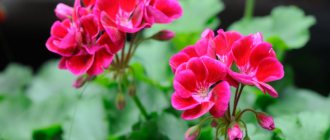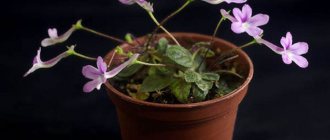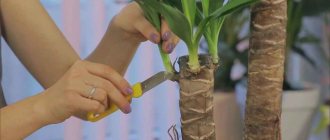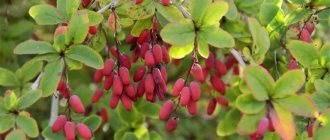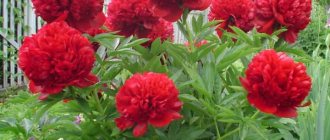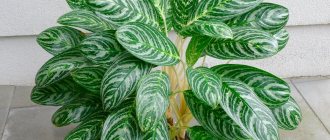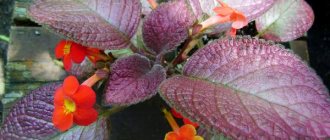Rhododendron has a wide variety of varieties that can be grown in any region, despite the low winter hardiness of the plant. At the same time, for propagation it is not necessary to purchase ready-made seedlings from a special nursery - it is enough to know how to propagate rhododendron in order to expand your collection of these plants on the site. Let us immediately note that rhododendron allows you to organize propagation by cuttings in water, layering, grafting and dividing the bush. All methods will be discussed in detail below.
Step-by-step instructions for propagation by cuttings
Cuttings of rhododendrons is one of the most productive ways of propagating them. The process is quite complex and time-consuming, but the result will please the owner.
Rhododendron in the nursery
It is worth cutting off branches for subsequent propagation of trees after they finish flowering. Thus, it is necessary to begin harvesting deciduous species at the end of May, but if we are talking about evergreen species, then cuttings of rhododendrons take place in the summer, before the 10th of July.
Additional Information! Deciduous and evergreen species take root better than others. All types of rhododendrons have one thing in common - long rooting.
Green shoots begin to become covered with a thin crust at the indicated time, and by mid-July lignification reaches the middle of the shoots.
It is necessary to cut 5-8 cm from the shoots so that there are at least 4 leaves on this segment with a couple of nodes between them. The shoots prepared in this way should be placed in a container with a previously filled nutrient substrate, which is sand and peat in equal proportions. It is recommended to make the soil layer at least 7 cm with the same level of drainage underneath. In this case, the drainage should be separated from the soil by 2 cm of coarse sand.
In the fall, the cuttings will take root, so they should be transplanted into boxes filled with an acidic substrate, which is prepared according to one of the recipes:
- 2 parts acid peat to 1 part pine needles;
- 1 part sand and pine needles to 2 parts acidic peat and leaf soil.
The cuttings are planted at a distance of 10 cm between them. The tops of the seedlings need to be pinched. Containers with plants need to be moved to a colder room, which is a basement or cellar. The temperature there should always be around 5 degrees Celsius. A deviation of 2-3 degrees is available.
Propagation of rhododendron by stem cuttings
With the onset of winter, the seedlings need to be moved to a bright place, with an air temperature of about 10 degrees Celsius. They will not be comfortable at room temperature, so care must be taken to create conditions favorable for growth.
In the spring it is worth planting plants in the ground: you can dig them both in containers and directly into the ground. The soil should have the same composition as it was during rooting. It is necessary to choose a good place so that the rays of the midday sun do not fall on the plant. After this, you should regularly water and spray the plant.
Important! The seedling will be ready for transplanting to a permanent place no earlier than after 2 years. For the winter, the plant should be covered with spruce branches or mulch. Care should be carried out as standard. Propagation by stem cuttings is most preferable for species such as azalea and wild rosemary.
Preparation of material. Timing for cuttings
This method of propagating rhododendron is considered quite labor-intensive. The optimal time for cutting cuttings is after flowering:
Preparing rhododendron cuttings
- for deciduous varieties - from May 20 to June 15;
- for evergreens - from June 20 to July 10.
At this time, green shoots begin to become covered with a thin crust. By July, lignification reaches half the length of any shoot. Best to take root:
- in evergreen species - semi-lignified cuttings;
- in deciduous plants - those that have just begun to become covered with bark.
Cut a suitable cutting 5-8 cm long from the shoot. It should also have at least 4 leaves and at least a couple of internodes. The cutting takes a long time to take root, so it is important to stimulate the plant in order to reduce this time as much as possible:
- Remove the lower leaves. There is no need to shorten the top ones. Strip the lower 2 cm of the shoot down to the cambium.
- Soak the cut site in a solution to stimulate growth: IAA, IBA (0.01%), heteroauxin or succinic acid (0.02% for deciduous, 2-4% for evergreen species).
How to propagate rhododendron from leaf cuttings
How to propagate hydrangea by cuttings in spring
The period for lignification of cuttings can be easily missed. If such a situation occurs, do not be upset, since the plant can be propagated in other ways. How to cut rhododendron with leaves? To do this, before the end of July, you need to cut off a leaf from a branch that has a couple of centimeters of bark and a bud.
Rhododendron blossom
The cut should be treated with a preparation that stimulates root growth. The substrate is prepared in the same way as for propagation by cuttings. It is necessary to deepen the cutting with a bud into the ground at a distance of 2 cm. With this method of propagating rhododendron, rooting occurs within 4 months. Initial signs can be observed during the first two months.
Important! If flowers begin to grow in the spring, they should be trimmed. The remaining manipulations for caring for the plant must be performed the same as when propagating by stems. As a result, you can get a beautiful rhododendron, the reproduction of which takes a long time.
General recommendations for cuttings
Rhododendrons today grow almost all over the globe.
Most species of these plants are in Asia. An important condition for the growth and development of the crop is high humidity. Therefore, they can most often be found high in the mountains. Rhododendrons are evergreen and deciduous. The height of the bush is from several centimeters to several meters. Rhododendron does not like drafts, but responds positively to partial shade and slightly acidic soils. Depending on the variety, during flowering the plant is covered with beautiful inflorescences of different shades.
For cuttings of shrubs, flexible annual shoots are used: leafy, lignified and semi-lignified. The plant is also propagated by dividing an adult bush, grafting, suckers and seeds.
Attention! A common property of rhododendrons is long-term rooting. Deciduous varieties sprout roots within 1-1.5 months, evergreen varieties take about 4 months.
Reproduction of rhododendrons by layering
How to propagate climbing roses by cuttings and layering
The layering method is different for other shrubs, so you need to know exactly how rhododendron reproduces using this method. Rooting other plants with layering is simple: you just need to bend and secure the branch. For this plant, the method becomes more complicated. Reproduction occurs in the spring.
In rhododendron, you need to select the outermost shoots to make layering easier. It is worth choosing the branches closest to the ground. You should not use several branches at once; it is recommended to make up to 5 layers at a time on the bush.
Reproduction of rhododendron by layering
At the point where the branch will touch the ground, you need to make a cut along the branch. You can avoid closing the incision by inserting a match into it. This is not necessary, but this technique allows you to speed up the growth of the plant. In the ground itself you need to dig a small hole 15 cm in diameter and depth.
Having bent the branch to the ground, it must be secured with a bracket or pin. From above you need to dig the shoot with an acidic substrate made according to the same recipe as for cuttings. The top of the shoot should be directed upward; to do this, it should be secured with a peg. In order for rooting to occur faster and better, it is necessary to organize regular watering so that the soil is consistently moist.
Additional Information! Roots may appear by autumn, which means they are ready for replanting. But if the region is famous for its harsh winters, then it is worth holding off on planting the bush, since the plant will not be able to adapt in time and will die. It is recommended to cover the cuttings with leaves and spruce branches until next spring.
Advice from experienced gardeners
Rhododendrons can be propagated in many ways. In addition to the existing algorithms for planting seeds, cuttings and layering, there are also some nuances of growing shrubs that experienced gardeners know about.
- Which rhododendron propagation method to choose depends on its individual characteristics and the type of shrub. Seed propagation is most often used to increase the population of wild rhododendrons. For varietal ornamental species, it is better to choose to plant rhododendron by cuttings or use layering, so the plants are more likely to take root successfully and retain all the characteristics of the main bush.
- For any propagation, it is necessary to take planting material only from strong and healthy plants. Sick and weakened rhododendrons will produce offspring that are equally weak and prone to wilting.
- When propagating rhododendron by cuttings at home, the plant may begin to form buds in its second year of life - even before planting in the ground. At this moment, it is best to cut off the buds and pinch the tops of the plant’s shoots; the fact is that early flowering is detrimental to the growth of vegetative mass. In the first years of a plant’s life, care should be taken primarily to ensure that it produces more strong roots and grows shoots.
- Cuttings of evergreen rhododendrons, as well as propagation by layering or seeds, is a more complex process than propagation of deciduous rhododendrons. Shrubs that shed their leaves for the winter are more unpretentious and, in general, are much more amenable to cultivation at home.
In general, for beginners, gardeners most recommend breeding rhododendrons by cuttings or layering. Both of these methods of propagation are very simple, while seed propagation or dividing a bush requires more experience and knowledge and also has significant disadvantages.
Propagation of rhododendrons by seeds
How to propagate lavender from a bush using cuttings
Seeds are not the most effective and easiest way to quickly propagate rhododendron from cuttings. Such a plant will begin to bloom in 5-10 years. Sowing should be done at the end of February or in the spring. Seeds are sown in containers that have drainage holes. The substrate for sowing is the same as in other methods of propagating rhododendron at home. The soil also needs to be pre-disinfected.
Rhododendron seeds
After completing the preparatory stages, sowing should begin:
- You need to pour the prepared substrate into a container, carefully level the ground, but do not compact it.
- Scatter the seeds on the surface infrequently so that subsequently thinning and picking of seedlings is done less often.
- Depending on the size of the container, it is necessary to water either through a tray or using a watering can with a fine mesh. Excess moisture should drain freely. Water the seeds with acidified or soft water.
- The container should be covered with film or glass.
It is worth placing the containers in a place with average room temperature. Shoots should appear in about a month; high air and substrate humidity must be maintained. It is necessary to remove the glass or film from young seedlings and move them to a colder room with a temperature of about 10 degrees. Plant picking is done in June.
Important! In the summer, it is recommended to place the plants in the garden or greenhouse at the dacha, but with the onset of cold weather, it is necessary to transfer containers with rhododendrons to a room with a temperature of up to 18 degrees. Plants need to be illuminated throughout the winter, since the duration of daylight for them is 17 hours.
You can transfer seedlings into the soil only in the third year after planting. This is done in the spring. But it is worth planting rhododendrons in a permanent place no earlier than the fifth year they are received from seeds.
Planting young rhododendrons in a permanent place
For rhododendrons obtained from seeds, cuttings or other methods, the place of cultivation is selected equally carefully. Plants do not like direct sunlight and windy areas. For them, secluded, protected places with diffused bright lighting or partial shade are chosen, placing rhododendrons under the canopy of trees or on the north side of buildings and small architecture. Usually rhododendrons are “combined” with conifers. These shrubs prefer loose, nutritious and high-quality soil mixtures with a pH reaction from 4.5 to 5.0. They are not suitable for clayey, dense, heavy, wet or damp soils with a risk of stagnant water or high groundwater levels.
Regardless of the propagation method, it is better to plant rhododendrons in a permanent place in the spring. For planting, prepare a soil mixture of peat, leaf soil and coniferous litter in advance. A portion of complete mineral fertilizer must be added to the soil and planting holes about 60-70 cm wide and deep are dug. For the shrubs, a high drainage layer of non-limestone materials is laid. The planting distance depends on the future size of the bush of a given variety or species and ranges from 70 cm for the most compact rhododendrons to 2 m for the largest.
The most difficult thing in planting rhododendrons is to monitor the depth of the root collar. Even taking into account soil shrinkage, it is necessary to install the seedling in the planting hole so that in the end the root collar is located 2-3 cm above the ground line. A watering hole is immediately created around the planting hole, completing the planting with abundant watering and mulching with pine needles or peat.
Planting a young rhododendron bush. © Evan Bean
Already from the first day after planting in a permanent place, full mineral fertilizers are applied to plants 2-3 times a year (in early spring and after flowering). During drought and when there are signs of water shortage, the bushes are additionally watered abundantly. It is better to keep the mulch layer in the tree trunk constant. Loosening the soil is carried out shallowly, after watering or heavy rainfall, regularly weeding. In the first year after planting in a permanent place, rhododendron bushes are not allowed to bloom.
Before the arrival of the first frosts, moisture-charging irrigation is carried out. In the first and next two years, the plants are covered with spruce branches and dry leaves, and deciduous rhododendrons are bent to the ground. If a variety requires more reliable shelter, it is carried out in compliance with all rules of agricultural technology. Plants obtained from seeds are less winter-hardy; for the winter they are covered with high hilling of the base of the bushes and careful covering with spruce branches. Evergreen rhododendrons need to be protected from sunburn.
Dividing the bush
Vegetative propagation is the production of a new organism from a part of the maternal one. In nature there are many ways of such reproduction, the simplest is division.
Dividing a rhododendron bush
How does street rhododendron reproduce in this case? Simply, when transplanting a plant, you need to divide the mother specimen into 2-4 daughter bushes.
The disadvantage of this propagation method is the small number of specimens that can be obtained, but this is enough for a small summer cottage.
Other ways to propagate these flowers
- Lateral layers. At the end of May, one of the bush shoots is pressed to the ground and sprinkled with peat. Allow such a “cutting” to take root for 1.5, or better yet, 2 years, and only after that cut off the mother branch and replant the resulting bush. By the way, it is believed that such propagation should not be used for all species, but it is suitable for deciduous azaleas.
- Air layering. The bark on one of the branches is carefully removed, and the wood is sprinkled with a root formation stimulator. This place is wrapped in damp sphagnum or peat and securely wrapped in foil. After the same 130 days, check your twig - if it has produced roots, you can cut it and transplant it into a box or a cozy place in the yard (be sure to cover such a bush with leaves for the winter).
- Dividing the bush. There are two methods available here: separation of the maternal offspring (difficult and responsible) or simple division (if the bush is old). All these manipulations are carried out when transplanting rhododendron.
- Graft. One of the most difficult methods. It is used by breeders when developing new varieties (scion and rootstock are taken from different species).
- Seeds. Another option for professionals. But avid flower lovers also use it. Seedlings must spend at least three years in the house. And such a plant will bloom even in its 9th year of life.
Grafting in greenhouse conditions
Evergreen rhododendrons are most often propagated by grafting. This is usually done by professionals, but you can also master a similar skill in greenhouse conditions. There are two methods of grafting - budding and copulation. The first involves grafting the bud or trunk of the rootstock onto the branch. Second, the scion cutting is fixed on another plant.
Rhododendron grafting
The graft shoot and scion must be combined so that they form a single organism. Over the course of several years, the cuttings should form their roots. In this way, more cold-resistant or fast-growing plants are developed.
Additional Information! As a rootstock, 3-5 year old plants grown in a nursery should be used. In most cases, annual semi-lignified shoots with well-formed buds are grafted.
Vaccination must be done at the end of winter or spring. In winter, plants are grafted in greenhouses. The rootstock should be prepared in the fall, before frost sets in. It should be dug up and transplanted into a pot, watered abundantly and kept at a temperature of 5 degrees Celsius. A couple of weeks before the procedure, the rootstock should be watered abundantly and kept in water at the same temperature.
It is worth grafting closer to the roots of the rootstock; the contact area should be covered with plasticine or garden varnish to avoid drying out, and also tied well with a plaster or electrical tape. Grafted plants should not be sprayed for two weeks; they must be kept at a temperature of 22 degrees.
Diseases of rhododendrons and their treatment
Rhodendrons are quite often attacked by various pests and affected by diseases. First of all, this happens when this plant is not properly cared for.
Main diseases of rhododendron:
- Trachemiocosis , another name for this disease is vascular wilting. This is a fungal disease. The main signs of damage appear in the form of the appearance of a gray coating on the stems and leaves, which very quickly begin to dry out. The main danger of this disease is metabolic disorders in the plant and rapid rotting of the root system.
At the first signs of trachemyocosis, you need to cut off the affected parts and destroy them. Under no circumstances should you throw them into the compost heap. After removing parts with a gray coating, the entire bush should be generously sprayed with Bordeaux mixture.
- Late blight rot - This is also a fungal disease. The first sign of this disease is the appearance of crimson or purple spots on the stems. If you dig up and inspect the roots, they will also have such spots. As a result of late blight rot, the entire root system begins to rot and the bush dies. For treatment, you need to treat the bush with any fungicidal agent and reduce the number of waterings.
- Leaf mosaic is a companion to plant damage by pests such as aphids. Signs of the disease are the appearance of green swellings on the leaves, and the leaf blade itself begins to turn yellow. This disease has practically no cure, therefore, to prevent it from spreading to other bushes, the diseased plant is destroyed. The best prevention of this disease is timely destruction of pests.
- Nitrogen starvation . This is more likely not a disease, but a lack of care. Occurs in plants grown on sandy soils. The main signs are shredding of leaves and cessation of flowering. To prevent nitrogen starvation, you need to fertilize the bush with nitrogen-containing fertilizers.
- Root rot is a very dangerous disease that is almost impossible to cure. Signs of this rot are drying of leaves and buds. In order to try to stop the course of the disease, you need to treat the bush with the drug Fitosporin-M.
In addition to being affected by various diseases, rhododendron can be attacked by insect pests.
Main insect pests:
- Rhododendron bug is the most common pest of rhododendron. The first signs of its appearance are former powdery spots on the leaves. To kill the insect, the bush is treated with preparations containing diazinon.
- Spider mite . This common pest appears during the dry season. The mite begins to suck the juice from the leaves, and they gradually dry out. The main sign of the appearance of this pest is small cobwebs on the bottom of the leaf blade. For destruction and prevention, the bush is periodically treated with fungicides.
- Mealybug is a very dangerous pest because it very quickly forms entire colonies. The insect infestation looks like small cotton balls; when rubbed, it leaves a red mark on the hands. To destroy, you need to treat the bush with karbofos.
- Narrow-winged miner moth . Rhododendron serves as both food and nest for her. She eats holes in some leaves and twists others into a tube, where she lays eggs. To combat it, the bush should be fumigated with sulfur. You can also spray with sulfur-containing preparations.
These are the main pests and diseases dangerous to rhododendron. Since this plant is very sensitive to all diseases, disease prevention is an integral part of rhododendron care.
Caring for seedlings before rooting
To minimize the rooting time of rhododendron, it is necessary to stimulate the plants.
Rhododendron seedlings
This is achieved by the following steps:
- It is worth removing the lower leaves so that 2 cm at the bottom of the cutting is exposed to the cambium.
- The cut site should be soaked in a special solution that stimulates rooting. They can be succinic acid, IAA, Heteroauxin.
The shoots should be planted so that the distance between them is at least 5 cm. After planting, it is necessary to water the plant generously from a watering can with a fine mesh, and then create greenhouse conditions by covering the container with the cuttings with film or glass. It is not recommended to leave plants in direct sunlight. It is recommended to ventilate the seedlings and lightly spray them in the morning and evening. It is worth observing the temperature for rooting plants: 15 to 20 degrees can be considered optimal.
In addition to decorative properties, rhododendron has a lot of useful properties: medicinal, tanning, soil-protective. A large number of people want to have it on their site, but not everyone wants to show courage and patience during the propagation and cultivation of these plants.
Care when growing Rhododendrons
In the first years of their life, Rhododendrons grow very slowly. At the same time, they need quite labor-intensive, careful care, which consists of the following:
- watering;
- applying fertilizers;
- shelter for the winter;
- trimming bushes.
abundant watering during their flowering and during the period of intensive growth of the bushes, when next year's flower buds are being laid. For good growth and development, Rhododendrons constantly require increased atmospheric and soil moisture. Therefore, it is necessary to regularly moisten the soil and frequently spray the bushes, especially in dry and hot weather. To water them, use water that does not contain lime: rain, from a pond or river. Tap water needs to sit for some time.
to improve the soil around Rhododendrons every 3-4 years. To do this, a nutrient mixture is introduced into the tree trunks of plants: rotted cow manure and completely decomposed compost. 1-2 buckets per bush, and slightly buried to depth. In April-May, mineral fertilizers are added along with water - ammonium sulfate, superphosphate, potassium sulfate. Before the plants begin to grow, liquid mullein is added, and then during the summer, a solution of the composition is added twice: potassium nitrate - 1 part, superphosphate - 2 parts. It is not recommended to apply fertilizers to planted plants before they are completely rooted, or in late autumn, so as not to cause untimely plant growth and freezing in winter.
Shelter for the winter is necessary so that Rhododendrons can survive wintering well in cold areas and do not suffer from lack of moisture. Before the soil freezes, they are watered generously. Then stakes are driven in around the bushes, the height of which should be higher than the bushes, so that the branches and buds at their ends are not crushed when covering. A layer of fallen leaves of 15-20 cm is poured into the tree trunk circle to insulate the roots. Crossbars are placed on the stakes, to which protective materials are tied - Pine or Spruce branches, in a layer of 10-15 cm.
Such protection is quite sufficient until the onset of snow cover, which will then reliably protect the flower buds even during the onset of very severe frosts. The main thing is that all these protective shelters allow the air the plants need to pass through well.
In the second half of April, protective coverings are gradually removed, making sure that the bright spring sun does not burn the evergreen leaves. In areas with a mild climate, shelters for Rhododendrons for the winter serve to protect their evergreen leaves from burns by the winter and early spring sun.
